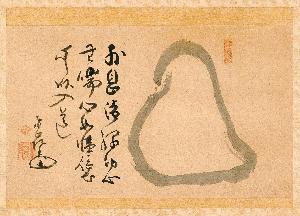Enji Torei
Enji Torei;Tōrei Enji
Place: Gokasho
Born: 1721
Death: 1792
Biography:
Introduction to Enji Torei
Enji Torei, a Japanese Zen Buddhist monk, teacher, author, painter, and calligrapher, was born on May 8, 1721. He is known for his influential text on Zen practice called "The Undying Lamp of Zen" (Shūmon mujintō ron), which gives an overview of Hakuin's views and practices with regard to the Buddhist path.
Early Life and Training
Enji Torei was born in Kazaki, Shiga prefecture. At a young age, he met the respected Zen master Kogetsu Zenzai (1667–1751), which inspired him to begin his studies at a local monastery. He later received his ordination as a Buddhist monk from Kogetsu Zenzai and studied under the direction of Hakuin Ekaku, a renowned Rinzai master.
Career and Influence
Enji Torei's career spanned over 40 years, during which he received Hakuin's robe and became his principal Dharma heir. He wrote the influential text "The Undying Lamp of Zen", which presents the Zen path according to the Rinzai tradition of Hakuin and attempts to promote the unity of all Buddhist schools under the Ekayana (One Vehicle) view of Zen. His work also attempts to reconcile Zen Buddhism with Confucianism, Shintoism, and Taoism.
Artistic Style
Enji Torei's artistic style is characterized by bold, sweeping strokes that convey a sense of movement and energy. His paintings, such as "Branch of Fruit Bearing Tree", showcase his unique style and technique. He is considered one of the most influential artists of his time, known for his innovative style and mastery of landscape painting.
Legacy
Enji Torei's legacy can be seen in the many contemporary Rinzai-lineages that stem from Hakuin and Torei. His students, including Gasan Jitō, Inzan Ien, and Takuju Kosen, went on to become prominent figures in the Zen Buddhist community. Enji Torei's work can be found in various museums, including the Indianapolis Museum of Art and the National Palace Museum.
- Important works: "The Undying Lamp of Zen", "Branch of Fruit Bearing Tree"
- Influential figures: Hakuin Ekaku, Kogetsu Zenzai
- Museums: Indianapolis Museum of Art, National Palace Museum
Conclusion
Enji Torei's life and work serve as a testament to the enduring legacy of Zen Buddhist art and philosophy. His contributions to the Rinzai tradition and his influence on contemporary artists make him a significant figure in Japanese art history. For more information on Enji Torei and his work, visit https://Wikioo.org/@/Enji-Torei or https://en.wikipedia.org/wiki/Tōrei_Enji.

